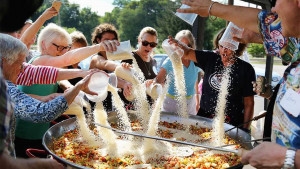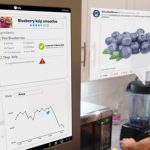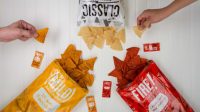A Fix For Food Waste And Hunger: Big Batches Of Soup
Cincinnati chef Suzy DeYoung used to run a high-end catering company that served everyone from visiting presidents to Bruce Springsteen. In 2014, however, she became tired of the trade-offs, which included making too much food to ensure choosy diners always had options, and buying only the freshest and prettiest produce while lots of just plain edible stuff went overlooked. “That always kind of haunted me and I hated that,” she says.
Many restaurant chefs (and more than a few home cooks) follow the same ethos. As a result, America wastes roughly 40% of available food. That seems particularly egregious in Cincinnati, where the childhood poverty rate is nearly double the national average, leaving many kids food insecure.
DeYoung’s answer was to found La Soupe, a nonprofit that collects leftover produce from grocery stores and local organic farms to make an array of flavorful and inventive soups, which are then frozen and redistributed locally to stop child hunger.
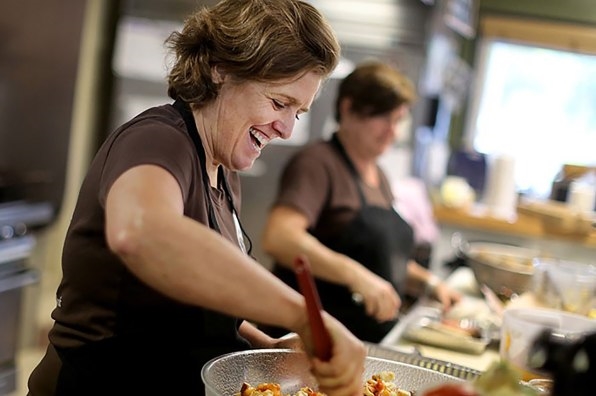
Last year, the group saved an estimated 125,000 pounds of produce from the landfill, serving 800 quarts a week through 47 participating agencies around city during the school year. By July, they’d already surpassed that amount of salvage, and expect to double it by the end of the year.
Based on a general one-pound-per-person estimate, DeYoung figures that means she’ll be making the equivalent of 250,000 meals annually to those in need. The group earned a Jacqueline Kennedy Onassis Award for outstanding local public service from the Jefferson Awards Foundation earlier this year.
La Soupe operates out of a 900-square-foot outpost called the Soupe Shack that’s in a poor rural area about 30 minutes east of downtown. To gather ingredients, DeYoung enlists 200 volunteers who use a modified version of Food Rescue US a donation delivery app that allows grocers to itemize what needs to be picked up, food banks to claim it, and participating drivers to agree to shuttle specific loads in between them.
That works well for a lot of leftover staples, but not really things on the verge of spoiling. Plus, food banks have their own limitations; not everyone has the time or transportation to reach one, or the right ingredients or kitchen appliances at home to turn what they could pick up into a proper meal.
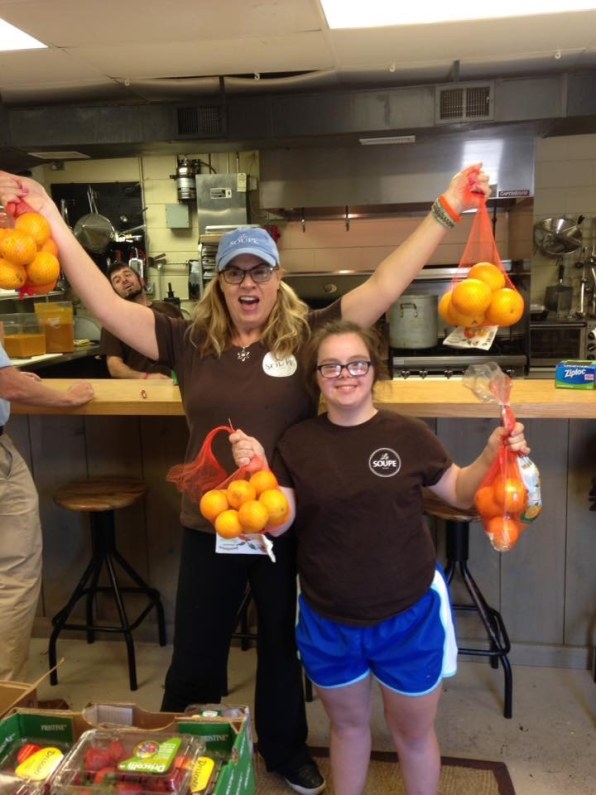
Instead, La Soupe’s volunteer fleet contracts with stores like Kroger, Jingle Jim’s, and produce suppliers like Crosset to collect and transport fruits and vegetables to DeYoung’s small commercial kitchen. There, they get sorted into bins for what needs to be used first in order to avoid spoiling. Whatever truly isn’t edible ends up as feed for local pigs and chickens.
DeYoung says the next step resembles a less glamorous, industrial scale version of Chopped, the Food Network TV show where contestants must prepare a dish from random ingredients. An abundance of cauliflower might be transformed into vegan chili, while loads of tomatoes become gazpacho.
Some recipes have meat, which travels a slightly different path to reach the kitchen. Whereas the produce goes from stores to straight to La Soupe, many stores still direct leftover meat to food pantries, where less common offerings of lamb, bison, and veal tend go unused. DeYoung often salvages that, and accepts deliveries of more common cuts from Sugar Creek, a national meat packer.
Each soup is frozen before being redistributed by the app-enabled volunteer fleet, often with a homemade salad mix and salvaged baked goods, through local schools, libraries, recreation centers, or faith organizations.
The group focuses on soup because it’s economical. “You can stretch it, meaning if all you have are potatoes and onions you can make a lot by adding water versus just giving somebody a potato,” she says. After talking to recipients, she realized that this also solved the lack-of-appliances problem. Some families might not know how to cook; those that do, though, might also have only a microwave or hot plate—either of which works find for rewarming.
The nonprofit’s total budget is $250,000 this year, which covers the salaries of three full-time and eight part-time employees, and is funded by a combination of public donations, community foundation grants, and a “pay from your heart model” for shoppers who want to buy the same meals directly from Soupe Shack for whatever price they deem it worth. (Most end up intentionally overpaying by 20% or so, DeYoung says.)
Now the only limitation is their space. The group is currently looking for a larger location, which it may also build itself, and plans to expand a pilot cooking class that’s worked well at the local high school. That course, part of an emerging program called “Cincinnati Gives A Crock,” provides kids with their own crockpot and recipes, along with raw ingredients so they can learn to start stretching their meals at home when possible.
The end goal is the make each La Soupe offering “available for anybody and everybody”—and good enough to make folks want seconds.
Fast Company , Read Full Story
(14)

